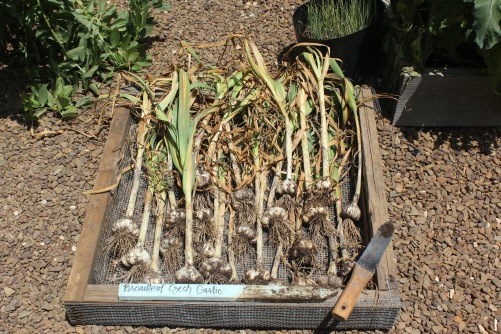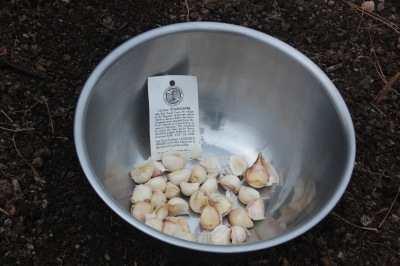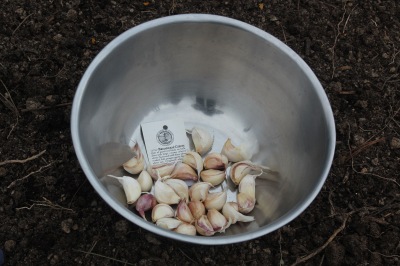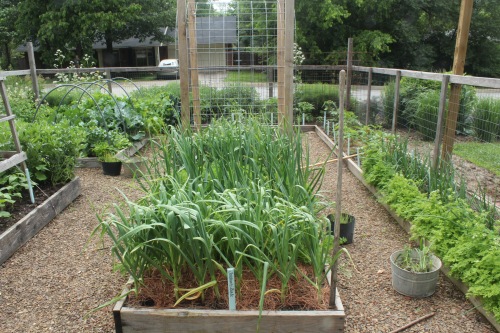I recently harvested my first crop of softneck garlic. (The hardneck is still out in the garden.)
I expected this to happen in July, but I’d been keeping an eye on it because the leaves were starting to turn brown and I knew that knowing when to harvest garlic was a matter of observation. A reading of the leaves as it were. When more of the leaves are brown than green the time is nigh. This is also the time to cut back on watering, so as to begin the curing process.
We’ve had a lot of rain lately, and I didn’t want them to rot, or plump up and split their skins, so I had been keeping an eye on the weather as well. I waited until we’d had a pretty dry run and then on June 24th, I did a test. I used my trusted hori-hori (Japanese soil knife) and gently loosened the soil around a bulb before pulling it out. I know what garlic looks like, but it was still exciting to pull up a fat head of perfectly formed garlic – it’s funny how easily I’ll take nature’s triumphs as my own.
I carefully pulled up the rest of them, gently brushing off some of the soil. They seem tough, but if they end up being stored for months, I didn’t want any damage to end up as an entry place for rot or disease – I’ll make sure to use any compromised heads first. I spread them out on a soil screen and placed them on bricks in my garage to complete their cure. A shady spot with good air flow is what they need. This should take 3-4 weeks. I’ll turn them every few days and when all the leaves are brown, they’ll be ready to clean and braid.
Garlic couldn’t be easier to plant and it’s a lovely way to end (or start) the gardening year. The last entry in my 2014 garden journal is from November 21st, the day I planted garlic. When everything in your garden is brown and crunchy it’s good for the soul to be planting anything. It closes the circle. Garlic gives you a great return on your investment and is yet one more reason to look forward to spring.
Most sources will tell you that it’s important to start with organic cloves, as those that come from the grocery store come from who knows where and are treated with who knows what (probably a sprout and root inhibitor). I ordered mine from Seed Savers Exchange (http://www.seedsavers.org) in early September. I chose Broadleaf Czech, and Tochliavri both softneck artichoke types, and German Red a large rocambole hardneck. I also picked some up at our farmer’s market and promptly forgot what kind they were. Music? I planted them anyway. A little mystery never hurt anyone. They’re hardneck, I’ve figured that much out.
There are basically two kinds of garlic – hardneck (Allium sativum var. ophioscorodon) and softneck (Allium sativum var. sativum). Sativum means cultivated in Latin.
Hardnecks send up a stiff flower stalk or “scape”, around which are circled a single row of cloves. They have fewer, larger cloves with a more complex, stronger flavor. There are three groups within the ophioscorodons; rocambole, porcelain, and purple stripes. The outer wrapper is looser, so they don’t store as long as softnecks.

Many growers remove the scapes to make sure the garlic channels its energy into making bulbs, not flowers. I haven’t done that yet, and I suppose I should. But I love the scapes! They seem so inquisitive, like a flock of boisterous birds. If you harvest them, or see some at the farmer’s market, they have lots of uses in the kitchen. You can chop them like a scallion and add them to scrambled eggs or stir-fries, you could make pesto with them, or pickle them.
Okay, I did an experiment, I cut off some scapes and left others, we’ll see if it makes a difference, or if I waited too long.
Softnecks don’t really have a stem. What they have is a pliable bundle of strappy leaves which can be braided together decoratively for storing. They are composed of several rows of smaller cloves all wrapped up in a tight outer wrapper. Softnecks store longer and travel better than hardnecks, thus they are the kind we most often encounter in grocery stores. There are two main groups of softnecks; artichoke and silverskin. The most common domestic variety is California silverskin.
Last November I prepared to plant garlic by digging compost and bonemeal into 2014’s fruit bed, knowing it would be this years root bed.
I separated each head into cloves.
And then pushed each one into the soil pointy-end up. I spaced them about 6″ apart.
And voila! Nothing to show for myself. That’s the thing about planting bulbs. Delayed gratification.
I mulched them pretty heavily with pine straw and then went inside for several months.
When spring sprung, so did they.
Here’s Wilson inspecting my work on March 16th.
May 25, 2015
Garlic is a true wonder food the history of which has been traced back at least 10,000 years to the mountainous regions of Central Asia. And unlike many of our highly manipulated modern foods with ancient antecedents, garlic has not been changed all that much from its wild form and therefore maintains most of its wild nutrients.
Notably, since the fall of the Berlin wall, hundreds of Russian varieties have been introduced which is why we are starting to see so many new cultivars. It’s fascinating how far political change can reach.
Garlic has antioxidant, antibacterial, antiviral, anticlotting, and anticancer properties. From the slaves who built the great pyramids, to ancient Olympian athletes, from Roman armies to French priests during the Black Death of the Middle Ages (English priests, who turned up their noses at it, didn’t fare as well) garlic has been used to improve strength, increase stamina, and for disease resistance. In WWI it was used to treat gunshot wounds and fight infection and during WWII it was dubbed “Russian penicillin”. Those Russians were on to something as common bacteria are one thousand times more likely to become resistant to our modern antibiotics than to garlic.
And while garlic is a good source of manganese, Vitamin B6, Vitamin C, copper, selenium, and phosphorus, what makes it the anti-everything King are its sulfur compounds, the most important of which is Allicin. Interestingly, allicin is not present in whole garlic but is created when garlic is cut or chewed. When this happens a protein fragment called alliin and a heat-sensitive enzyme called alliinase react with each other to form allicin. AND, if you immediately add heat to the equation most of that all-important sulfur compound and the benefits thereof are negated. So if you learn anything from this post, learn what I recently did. Once you slice, chop, or press your garlic, let it sit for ten to fifteen minutes before you heat it. This will allow the maximum amount of allicin to be created and you can reap all those lifesaving benefits.
Vive la Garlic!











